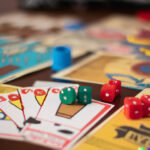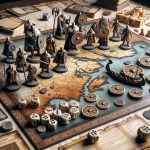History of Hnefatafl Development
The game of Hnefatafl, also known as ‘King’s Table,’ began its transformation during the Ancient Norse period and slowly spread to different countries and regions. As it traveled through the Viking Age, it picked up elements from other cultures that changed its rules and created numerous different variants. One of the earliest pieces of evidence is a carving from a 7th century Altar in Mästermyr, Gotland which depicts a board with a pattern similar to that found on modern Hnefatafl boards. By 1000 CE, Hnefatafl had become more established in England, Ireland and Scotland as well as Italy.
As demands from different cultures shaped the game further, it evolved over time by taking on new names such as Alea Evangelii or Paris chess in Europe. In some countries these adaptations were integrated into existing games such as skakki (Icelandic for “chess”) or tabula (Roman for “table”). Although variants developed across Europe over time there were also basic similarities maintained throughout various gaming adaptations. For instance, many variables like the parameters of play, types of pieces moved around the board between players remained consistent across most versions played at that time – this is because they all had their origins in the same game created by early Vikings.
In recent times the game has undergone resurgence due to renewed popular interest sparked by its appearance on TV series such as Game of Thrones. Nowadays official sets can be bought commercially and some form of basic instruction booklet included in the pack allowing players to learn strategy quickly with minimal effort!
Variations of Hnefatafl
Hnefatafl is an ancient board game known for having been played by Vikings. It has variations that have been discovered in different countries over time. Among the most famous of these variations are Tablut from Hungary and a version from the Isle of Lewis, Scotland.
The Tablut variation closely follows conventional Hnefatafl regulations with a few changes, such as allowing the king to have eight directions of movement rather than four. This version also requires special pieces called “guards” which can move around the board more freely compared to other pieces on it. The Isle of Lewis variation uses a rectangular board instead of its conventional square board, and it includes additional pieces in addition to those typical of Hnefatafl. The two additional pieces are considered martyrs, who can act as defenders to protect the king piece within their adjacent squares and delay capture by attackers.
Popularity of Hnefatafl
Recently, there has been a renewed interest in Hnefatafl, an ancient board game dating back to Viking times. The game rose to prominence during the Viking era and was later adopted by other European cultures. It remained popular for centuries before gradually disappearing as chess became more popular in the Middle Ages.
However, since its rediscovery in the 19th century and a modern reinterpretation of it, the game has once again become widely played around the world. People from all different cultural backgrounds are now picking up this ancient game and incorporating it into their hobby or lifestyle collection.
There is increasing interest especially among historians and those studying Ancient Scandinavian culture. Various organizations dedicated to preserving historical artifacts have created interpretations of the game using original designs to ensure accuracy. This, combined with products made available by commercial markets, has seen an increase in sellers producing replicas of this traditional Viking pastime.
Hnefatafl enthusiasts can be found all across the globe and regularly organize tournaments at various venues worldwide. While many fans choose to play online through digital applications or video games inspired by these historical board games, more traditional versions still remain hugely popular amongst players today as people seek out a new challenge with its complex strategies and rulesets that don’t feel outdated even after hundreds of years.
DIY Hnefatafl Board
Materials Needed:
1. One backgammon board or two stiff pieces of cardstock and sharp diagonal lines taken randomly to it (for the bases).
2. 24 coins ” 12 with four-finger marks, 12 with six-finger marks.
3. A piece of black felt which is roughly 1 foot square
4. Several feet of ribbon or string in a colour which should contrast the felt (black and white is a good option)
Assembly Instructions:
1. Lay out your backgammon board and use it as a template for drawing an 11×11 grid on the black felt, with the dice at one end of the diagonal line. Leave about an inch all around for trimming down later if required.
2. Place your 12 circular coins marked with 4 fingers in positions which correspond to the king’s castles on each end of the board; then place your remaining 12 circular coins marked with 6 fingers in roles which correspond to soldiers scattered along both sides of the king’s castle walls.
3. Cut three 2 foot lengths of contrasting ribbon or string and arrange them like spokes lying off one another so that they meet near centre point (with this assembly you will have created 3 circles each running into another) securely tuck any excess material under the corners nearby so that everything lies flat against the game board surface ” this will give you your Hnefatafl field pattern design. For added security use clear tape if necessary at certain points throughout construction process
4. When finished playing simply break apart spokes of field pattern and fold up board making sure pieces are packed away safely until next time you wish to bring out this ancient Viking fun!
Advice from the Pros
According to Dr. Timothy Rilde, a professor of Norse studies at Columbia University, the best strategies for winning at hnefatafl are rooted in understanding how the game is played. He explains that knowledge of the game is vital; knowing when to make certain moves and when to protect vulnerable pieces can mean the difference between victory and defeat.
Dave Monteyne, a gaming enthusiast and author of “The Ultimate Guide to Hnefatafl”, suggests players focus on forming defensive lines with their pieces in order to restrict their opponent’s movement across the board and prevent them from taking valuable spaces. He also recommends trying to dominate one side or corner area of the board, as they can be used as a secure base or jumping-off point for controlled advances during later rounds.
Finally, John Hallahan, an international referee certified by The International Hnefatafl Federation (TIHF), states that having patience is key when playing hnefatafl. He says players should take time between moves to anticipate their opponents’ strategies as well as to plan their own offensive and defensive maneuvers for future rounds. “In hnefatafl it pays off not to rush things,” he says “Take your time and make sure you have thoroughly evaluated every decision before committing.”
Making It Fun
One suggestion for making the game of Hnefatafl more exciting and dynamic is to create new rules, such as allowing pieces to move diagonally or introducing a jump move. Adding a fantasy element can also make the game more fun by introducing additional pieces or monsters into the mix. For example, you could have dragons that act as powerful guardians protecting certain areas on the board. Alternatively, Vikings could have magical weapons that give them an advantage during battles. Other ideas include adding special powers to certain squares on the board or affording units special bonuses when they successfully capture a piece. By coming up with creative new ideas and variations, it’s possible to reinvent Hnefatafl in ways that make the game more accessible and exciting to modern players.

I love playing all kinds of games – from classics like Monopoly to modern favourites like Ticket to Ride.
I created this blog as a way to share my love of board games with others, and provide information on the latest releases and news in the industry.





